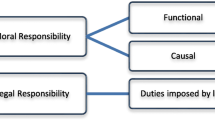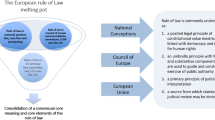Abstract
The exclusionary principle in English contract law is a long established but controversial rule of contractual interpretation. This article considers the jurisprudential origins of the principle and critically analyses judicial justification of the principle. This article also puts forward a case for how the principle can be reformed in order to introduce greater fairness within the process of contractual interpretation.
Similar content being viewed by others
Notes
Nicholls (2005).
[2009] UKHL 38.
[1998] 1 WLR 896 (HL).
See for example Javis and Kramer (2009).
(2010) UKSC 44.
[1971] 1 WLR 1381.
Per Lord Hoffmann at par. 30. Lord Hoffmann went onto cite the cases of Bank of Scotland v Dunedin Property Investment Co Ltd 1998 SC 657 and Alexious Campbell (2007) UKPC 11 in support of his comments that the binding force of the rule has been acknowledged.
(1822) 1 Sh App 309.
The Lord Chancellor did not hesitate in rejecting evidence of previous correspondence “My Lord, all the previous correspondence I lay entirely out of the case, because I cannot conceive that anything can be more dangerous than the construing deeds by the effect of letters and correspondence previous to the execution of them”.
(1878) 3 App Ca 552.
(1911) 104 LT 85.
[1971] 1 WLR 1381. See also McKendick (2010).
See also Lord Wilberforce’s judgement in the case of Reardon Smith Line Ltd v Yngvar Hansen-Tangen [1976] 1 WLR 989 in which he reiterated the purposive approach to the interpretation of contracts: “No contracts are made in a vacuum: there is always a setting in which they have to be placed. The nature of what is legitimate to have regard to is usually described as ‘the surrounding circumstances’ but this phrase is imprecise: it can be illustrated but hardly defined. In a commercial contract it is clearly right that the court should know the commercial purpose of the contract and this in turn presupposes knowledge of the genesis of the transaction, the background, the context, the market in which the parties are operating…” Further, Lord Steyn noted the shift in the court’s approach to interpretation in Deutsche Genossenschaftsbank v Burnhope (2995) 1 WLR 1580 at 1589 when he observed that: ‘parallel to the shift during the last two decades from a literalist to a purposive approach to the construction of statutes there has been a movement from a strict or literal method of construction of commercial contracts towards an approach favouring a commercially sensible construction’.
Sir Christopher Stoughton prefers Lord Wilberforce’s’ argument that subjective evidence of the intentions of the parties is excluded because it is unhelpful rather than being excluded on grounds of practical policy as argued by Lord Hoffmann in Investors Compensation Scheme. Sir Christopher argues that such evidence: “does not tell one what one needs to know—the common intention of the parties when the contract was made” (Stoughton 1999).
(1998) 1 WLR 898. Although judges have attributed the modern approach to contractual interpretation to Lord Hoffmann it is interesting to note that Lord Hoffmann himself pointed to Lord Wilberforce as the instigator of the modern approach to interpretation. This is evident when Lord Hoffmann stated “the fundamental change which has overtaken this branch of the law, particularly as a result of the speeches of Lord Wilberforce”. For recent cases which illustrate the application of Lord Hoffmann’s principles, see the Court of Appeal cases of Mediterranean Salvage & Towage Limited v Seamar Trading & Commerce Inc (2009) EWCA Civ 531 and ING Bank NV v Ros Roca SA (2011) EWCA Civ 353.
See Buxton (2010).
For recent examples of the principles of interpretation being applied see Best Buy Co. Inc. v Worldwide Sales Corporation Espana (2011) EWCA Civ 618 and Arqiva Ltd v Everything Everywhere Ltd (2011) EWHC 1411 (TCC).
McMeel (2005).
(2001) 2 WLR 735.
A relaxation or departure from the exclusionary rule was also judicially advocated by Thomas J in Canterbury Golf International Ltd v Yoshimoto (2001) 1 NZLR 523. However, Lord Hoffmann, giving the judgment of the Privy Council in that case, declined to re-examine the law surrounding the admissibility of pre-contractual negotiations in construing contracts and simply reaffirmed Lord Wilberforce’s argument that this type of evidence would be “unhelpful”.
A similar policy approach is taken in respect of the law surrounding the incorporation of arbitration clauses. For discussion see Ahmed (2010)
Chartbrook Limited v Persimmon Homes Limited (2008) EWCA Civ 183 at 111.
For example Lord Nicholls and E. McKendick Contract Law.
Principles of European Contract Law (1999) article 5.102.
Unidroit Principles of International Commercial Contracts (2010) article 4.3.
[1976] 2 Lloyd’s Rep 708.
[1981] 2 Lloyd’s Rep. 40.
See the arguments of McLaughlan ‘Contract Interpretation’.
See O’Sullivan (2009).
(2009) EWHC 1751 (Comm) at 25. See also comments by P. S Davies ‘Negotiating the boundaries.’
R. Buxton, “Construction”.
At 99.
Hugh Collins (2003).
(2010) UKSC 44.
The without prejudice rule is firmly established on public policy grounds which were confirmed in the recent House of Lords case of Ofulue –v- Bossert [2009] UKHL 16. The majority of their Lordships dismissed the claimants’ appeal to admit without prejudice correspondence and reaffirmed the need to protect the public policy behind the rule which was to encourage the negotiation and settlement of disputes. Lord Scott dissented and argued that issues between the parties which is ‘common ground’ and which have been discussed during without prejudice negotiations should be permitted to be used as evidence in subsequent proceedings. Lord Scott warned: “A public policy rule should not be allowed to extend further than the public policy in question requires and to apply the rule mechanistically, without regard to the limits that the purpose underlying the rule should dictate, cannot, in my respectful opinion, be right.” Lord Neuberger, however, voiced caution in creating exceptions to the rule and argued that such a practice would “…severely risk hampering the freedom parties should feel when entering into settlement negotiations.” For an analysis of their Lordships’ judgements in Ofulue see Ahmed (2009). Zukerman (2011) has voiced concern with the Supreme Court’s ruling in Oceanbulk. Professor Zukerman argues that the Supreme Court’s ruling means that settlement negotiations are now “without prejudice except for interpretation”, with the result that parties have to be much more careful about what they say in the course of settlement discussions and therefore has the undesired effect of undermining the valid policy reasons upon which the rule stand. He warns: “It is possible that negotiating parties would be more circumspect and careful in their exchanges now that they can no longer be sure that what they say would not be used to their disadvantage later on.”
Unilever Plc v Procter & Gamble (2000) 1 WLR 2436.
In Unilever Plc v Procter & Gamble Robert Walker LJ described three of the most relevant exceptions to the without prejudice rule at page 2444: “(1) …when the issue is whether without prejudice communications have resulted in a concluded compromise agreement, those communications are admissible … (2) Evidence of the negotiations is also admissible to show that an agreement apparently concluded between the parties during the negotiations should be set aside on the ground of misrepresentation, fraud or undue influence … (3) Even if there is no concluded compromise, a clear statement which is made by one party to negotiations and on which the other party is intended to act and does in fact act may be admissible as giving rise to an estoppel. That was the view of Neuberger J in Hodgkinson & Corby Ltd v Wards Mobility Services Ltd (1997) FSR 178, 191 and his view on that point was not disapproved by this court on appeal.”
Woolf (1996). Available on: http://webarchive.nationalarchives.gov.uk/+/http://www.dca.gov.uk/civil/final/index.htm (Accessed August 2012).
Rule 1.1 (2).
Rule 3.1.
Civil Procedure Rule 26.3 and Practice Direction 26. Practice Direction 26 begins with a reminder of the other CPR rules when dealing with allocation and those rules include the Overriding Objective (Part 1) and the court’s case management powers (Part 3).
See CPR 32.1(1)).
At 99.
References
Ahmed, M. 2009. Protecting the without prejudice rule. CJQ 28(4).
Ahmed, M. 2010. Arbitration clauses: Fairness justice and commercial certainty. Arbitration International 26(3): 409.
Buxton, R. 2010. “Construction” and rectification after Chartbrook. CLJ 69(2): 253.
Collins, Hugh. 2003. Objectivity and committed contextualism in interpretation. In Commercial law and commercial practice, ed. Sarah Worthington. Surrey: Hart Publishing.
Davies, P.S. 2011. Negotiating the boundaries of admissibility. CLJ 70(1): 24–27.
Javis, J., and A. Kramer. 2009. Refining or reforming construction. JIBFL 9: 522.
Lewison, K. 2007. The Interpretation of contracts, 4th ed. London: Sweet and Maxwell.
McKendrick, E. 2005. The interpretation of contracts. LQR 121: 158.
McKendick, E. 2009. Contract law. London: Palgrave Macmillan Law Masters.
McKendick, E. 2010. Contract law, text, cases and materials, 4th ed. Oxford: OUP.
McLauchlan, D. 2009. Contract interpretation: What is it about? Sydney Law Review 31: 5.
McMeel, G. 2005. Language and the law revisited: An intellectual history of contractual interpretation. CLWR 34(3): 256.
McMeel, G. 2007. The construction of contracts: Interpretation, implication and rectification. Oxford: OUP.
Nicholls, D. 2005. My Kingdom for a horse: the meaning of words. LQR 577.
O’Sullivan, J. 2009. Say what you mean and mean what you say: Contractual interpretation in the house of lords. CLJ 68(3): 510.
Staughton, C. 1999. How do the courts interpret commercial contracts? CLJ 58(2): 303.
Woolf, H. 1996. Access to justice: Final report to the lord chancellor on the civil justice system in England and Wales. Available on: http://webarchive.nationalarchives.gov.uk/+/http://www.dca.gov.uk/civil/final/index.htm. Accessed Aug 2012.
Professor Zukerman. 2011. Without prejudice interpretation—with prejudice negotiations. Evidence and Proof 15(3).
Author information
Authors and Affiliations
Corresponding author
Rights and permissions
About this article
Cite this article
Ahmed, M. Reviewing the exclusionary principle in English contract law. Liverpool Law Rev 33, 111–131 (2012). https://doi.org/10.1007/s10991-012-9117-5
Published:
Issue Date:
DOI: https://doi.org/10.1007/s10991-012-9117-5




